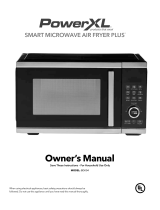
8INSTALLATION
† IEC 60705 RATING STANDARD. Specifications
are subject to change without prior notice.
Installation Requirements
Installation Location
Make sure you have enough space and support.
• Mount the oven against a flat, vertical wall, so it
is supported by the wall. The wall should be
constructed of a minimum of 2" x 4" wood
studding and 3/8" thick drywall or plaster/lath.
• Attach the 2 lag screws supporting the oven to a
vertical, 2" x 4" wall stud.
• DO NOT mount the microwave oven to an island
or peninsula cabinet.
• Be sure that the upper cabinet and rear wall
structures can support 150 lb. plus the weight of
any items you place inside the oven or upper
cabinet.
• Locate the oven away from areas with strong
drafts, such as near windows, doors, and large
heating vents.
• Make sure that you have enough space. See the
clearance diagrams in the installation manual for
the minimum vertical and horizontal clearances.
• Refer to the Installation Instructions for
details.
Electrical Requirements
The oven is designed to operate on a standard 120
V/60 Hz household outlet. Be sure that the circuit is
at least 15 A or 20 A and the microwave oven is the
only appliance on the circuit. It is not designed for
50 Hz or any circuit other than a 120 V/60 Hz
circuit. No other electrical appliances or lighting
circuits should be on this line. If in doubt, consult a
licensed electrician.
Voltage Warning
The voltage used at the wall socket must be the
same as specified on the oven name plate located
on the back or on the side of the control panel of
the oven. Using a higher voltage is dangerous and
may result in a fire or other type of accident
causing oven damage. Low voltage will cause slow
cooking. If the microwave oven does not perform
normally in spite of proper voltage, unplug and
reconnect the power cord.
Do Not Block Air Vents
All air vents should be kept clear during cooking. If
air vents are covered during oven operation the
oven may overheat. To prevent damage to the
oven, a sensitive safety device detects overheating
and automatically turns the oven off. The oven
cannot be used until it has cooled sufficiently.
Grounding Instructions
This appliance must be grounded. In the event of
an electrical short circuit, grounding reduces the
risk of electric shock by providing an escape wire
for the electric current. This appliance is equipped
with a cord having a grounding wire with a
grounding plug. The plug must be plugged into an
outlet that is properly installed and grounded.
• Consult a qualified electrician or service person if
the grounding instructions are not completely
understood, or if doubt exists as to whether the
appliance is properly grounded.
- Do not use an extension cord. If the power
supply cord is too short, have a qualified
electrician or serviceman install an outlet near
the appliance.
• Ensure that the product is properly grounded
before use.
• Keep the electrical power cord dry and do not
pinch or crush it in any way.
• For a permanently connected appliance:
This appliance must be connected to a
grounded, metallic, permanent wiring system, or
an equipment grounding conductor should be
run with the circuit conductors and connected to
the equipment grounding terminal or lead on
the appliance.
• Improper use of the grounding can result in a
risk of electric shock.
• Do not use extension cord. If the power supply
cord is too short, have a qualified electrician or
service man install an outlet near the appliance.
• A short power supply cord is provided to reduce
the risks resulting from becoming entangled in
or tripping over a longer cord.
us_main.book.book Page 8 Friday, February 11, 2022 8:30 AM



